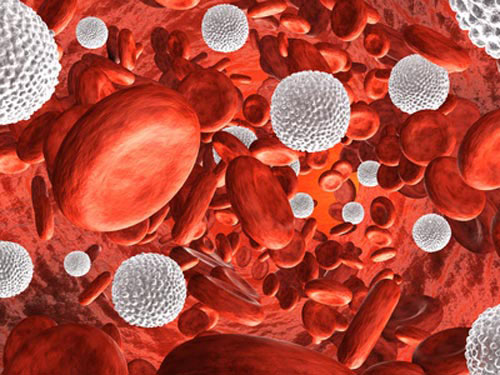The results from in vitro and in vivo studies suggest that targeting a pathway that is essential for the survival of certain types of acute myeloid leukemia (AML) could offer a new therapeutic strategy. The research, by scientists at the Wellcome Sanger Institute, found that a specific genetic mutation that is linked with poor prognosis in blood cancer is involved in the development of the disease when combined with other mutations in mice and in human cell lines.
Reported in Nature Communications, the findings provide new insights into how the loss-of-function mutation in the CUX1 gene leads to the development and survival of AML. The results suggest that identifying a pathway that is essential for these cancer cells to continue growing could lead to new, targeted therapies for some patients.
Saskia Rudat, PhD, co-first author and postdoctoral fellow at the Wellcome Sanger Institute, said, “By investigating the role of CUX1 further, we now have new insight into how this gene, and the lack of it when mutated, plays a key role in the survival of blood cancer cells. While this mutation doesn’t seem to cause the development of malignant disease on its own, focusing on the pathways involved with CUX1 is a good target for further research.”
Rudat and colleagues described their work in a paper titled, “Cut-like homeobox 1 (CUX1) tumor suppressor gene haploinsufficiency induces apoptosis evasion to sustain myeloid leukemia.”
Cancers develop following the accumulation of somatic genetic mutations that either activate oncogenes or disable tumor suppressors, the authors wrote. Suppression of both copies of a tumor suppressor gene (biallelic inactivation) is a well-known mechanism underpinning tumor development, but less is known about the contribution of loss/mutation of a single copy (monoallelic) of a tumor suppressor gene to tumor development.
“The human genome harbors around 1,400 putative transcription factor genes of which ~100 genes have been found to be mutated in cancer and approximately half of these genes are implicated as tumor suppressors, with only a handful of these genes implicated as haploinsufficient tumor suppressors,” the team noted. “Although some progress has been made in the therapeutic targeting of gain-of-function oncogenic transcription factors, loss-of-function transcription factor tumor suppressors represent difficult targets for direct therapeutic intervention, necessitating alternative approaches to target malignancies harboring such lesions.”
Acute myeloid leukemia is an aggressive blood cancer that affects people of all ages, often requiring months of intensive chemotherapy and prolonged hospital admissions. Mainstream AML treatments have remained unchanged for decades and fewer than one in three people survive the cancer.
Previous large-scale DNA sequencing analysis by researchers at the Wellcome Sanger Institute had identified loss-of-function mutations in the CUX1 gene on chromosome 7q in several types of cancer, including AML, where it is associated with poor prognosis. However, the role of the gene in AML development hasn’t been clear. “Our previous work in mice identified CUX1 as a potential T-cell leukemia tumor suppressor gene …” they wrote. “However, the role of CUX1 loss and PIK3IP1 in myeloid malignancies remains obscure … In this study, we sought to identify genetic vulnerabilities in CUX1-deficient AML cells using CRISPR-Cas9 screening to assess whether CUX1 deficiency invokes adaptive cellular pathways critical for leukemia survival.”
For their newly reported study, the team used CRISPR-Cas9 gene-editing technology to show that lack of functioning CUX1 leads to expansion of certain types of blood stem cells, which are defective in apoptosis, a form of regulated cell death. Their work indicated that the loss of CUX1 causes increased expression of the CFLAR gene—which encodes a protein that restrains apoptosis—potentially providing a means for mutated cancer cells to evade cell death and propagate. “Using a murine CUX1-deficient leukemia model and human cells, we establish that CUX1-deficient leukemia cells rely on elevated levels of CFLAR to evade apoptosis,” the investigators stated. “Our study reinforces the importance of apoptosis control in myeloid leukemogenesis and particularly highlights the significance of the extrinsic apoptosis pathway in AML survival associated with CUX1 haploinsufficiency.”
Their experiments showed that targeting CFLAR, or apoptosis evasion pathways in general, could be a possible treatment approach for people with this type of AML that is linked to poor prognosis. Currently, there are no clinically approved drugs that target CFLAR. “Our study indicates that tumor suppressor haploinsufficiency is sufficient to induce an apoptosis stress-mitigating pathway which is essential for leukemic cell survival—a state we refer to as haploinsufficiency-induced gene addiction,” the scientists noted. “Moreover, our data directly link a transcription factor (CUX1) in mediating this apoptosis-control pathway addiction through transcriptional regulation of CFLAR expression.”
Emmanuelle Supper, PhD, co-first author and postdoctoral fellow at the Wellcome Sanger Institute, commented, “By building on our previous analysis, this research has allowed us to gain crucial information about the development of this disease, and would not have been possible without the new and exciting CRISPR-Cas9 and genome sequencing technologies that enable us to investigate genetic weaknesses in cancer. Understanding more about the genetic basis of disease, and how multiple mutations come together to cause blood cancer is vital if we hope to save lives in the future.”
Chi Wong, MD, senior author and Wellcome clinical fellow at the Wellcome Sanger Institute and honorary consultant hematologist at Addenbrooke’s Hospital, said, “Acute myeloid leukemia is a devastating disease, which is currently difficult to treat, especially in cases characterized by genetic lesions such as loss of CUX1 and chromosome 7q deletions. This new study provides evidence that could be used to help develop new targeted treatment for some people living with acute myeloid leukemia, offering hope for this group of patients who unfortunately are more likely to have a poor prognosis.”


